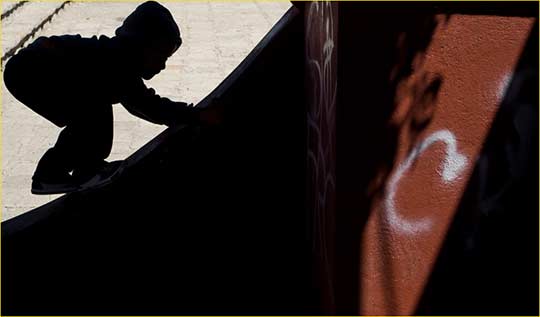
Climbing The Curve
San Miguel de Allende, Mexico. March, 2013
Sony NEX-7 with Leica 28-35-50mm Tri-Elmar @ 50mm and @ ISO 200
The Wait
Have you ever factory-ordered a new car, and waited and waited for it to be made and then delivered? It’s almost spring, new car fever is a tough one, and I’m going through it right now. (A 2014 Jeep Grand Cherokee – if you must know). But waiting for a new camera to appear, especially a new Leica M, is equally as frustrating for me, especially as I have been a life-long Leica user.
So – here we are. It’s early March and the new Leica M, (M-240 to its friends), has just started to become available to dealers. But I don’t have one. Not even a review sample.
This isn’t Leica’s fault. I have been a Leica user, tester, reviewer and collector since I was knee-high to a Summicron. But because I have been in Mexico all this past winter, and pre-production Leica M240 test samples and Mexico’s less-than-cooperative customs service don’t quite get along, I have thus-far been unable to shoot with, test, or report on the new M.
Originally, anticipating that I might get one sent here over the winter, I brought some M lenses south with me and have been using them on my Sony NEX-7 as a surrogate . It is thus, with at least a month to go till I get to try the new Leica M, that I decided to do a small commentary on my experience using Leica M lenses on the NEX-7. I’ll also share some thoughts on the place of the new M in the 2013 taxonomy of cameras.
Lenses – Sensors – Features : Pick any Two
There are three obvious factors when it comes to image quality, which also has to include usability and convenience. These are – the choice of lens, the camera sensor’s size, resolving capability and sensitivity, and of course how well a particular combination of the first two, along with the characteristics of the camera itself come together and form a gestalt.
Sadly, it isn’t often that all three can advantageously converge in a single device and are able to be totally convincing and effective as a tool for creative photography.
Lenses
I would argue (as would a great many others) that there is likely no finer family of lenses –ever– than those made by Leica. Leica’s now defunct R series lenses and its current magnificent S series are also equally superb, and have their ardent proponents. But the M series is in a class by itself, with hundreds of lenses and lens variations over more than a sixty year period to choose from.
One of the great appeals of Leica M lenses, beyond their spectacular imaging capability, is their small size and extremely high build quality. M lenses, when held in one’s hand can only be considered as the equivalent of a fine watch in terms of their precision of manufacture. Given their very high prices, both new and used, these are purchases for a lifetime. This is especially true now in the digital era, when new technology continuously replaces the old when it comes to cameras and sensors. Buta fine lens, especially an M lens,is a joy forever, to paraphrase John Keats.
Which brings us to the upcoming new Leica M. At US $6,995 this camera appears to be the culmination of six decades of M body development, and is the third major iteration of the digital M. Not only does it have a 24 Megapixel full-frame CMOS sensor, allowing for Live View and video, but the camera has an accessory EVF in addition to its traditional window range-finder / viewfinder.
This means that the new M will have three methods of framing, viewing and focusing an image; via the traditional optical viewfinder / rangefinder, via the rear LCD, and via the optional electronic viewfinder. But, for better or worse, in each case focusing is by hand and by eye. Autofocus is non-existent and simply not part of the M gestalt.
Street Tortillas
San Miguel de Allende, Mexico. March, 2013
Sony NEX-7 with Leica 28-35-50mm Tri-Elmar @ 35mm and @ ISO 250
Of course this is what Leica M owners have traditionally expected, so no complaint is made nor should one be expected. Indeed the new M adds Live View as a means of composition and focusing, and there is also focus peaking – a feature which I am proud to claim some credit for on the new M, as I pushed very hard for it during early design meetings with Leica management, and at the time was told that it likely wouldn’t be possible. Fortunately it was, and it is.
Live View isn’t a feature by any means unique to the M. Indeed they are late to that particular party because the new M is Leica’s first generation of CMOS equipped sensors in this series. Just about every other camera in the world has had Live View for quite a few years now. Only Medium Format backs now still use CCD sensors among mainstream imaging systems.
Be aware though that Live View on the M is similar to Live View on a DSLR. What I mean by this is that when LV is enabled the shutter mechanism is open to the CMOS sensor for framing and focusing. Then, when the shutter release is pressed the shutter itself has to close, then reopen as the exposure is made, close to end the exposure, and then the shutter reopens to enable Live View again. On no camera with this implementation of Live View (my Nikon D800e does the same thing), is shooting fast. For that the M240 should be used in its traditional optical finder mode.
But cameras designed from the get-go as electronic finder cameras (such as the NEX-7) have an electronic front shutter, which means that the sensor is live and open to the lens at all times. This makes the act of exposure much quicker and obviously much less noisy. Why the M240 isn’t equipped with an electronic front shutter is a question for Leica’s design engineers to answer.
A Sony NEX-7
The NEX-7 features full-time Live View through a high-refresh-rate built-in electronic viewfinder as well as via the rear articulated LCD. It also has a very nicely implemented Peaking feature for use with just about any lens that can be mounted, and that includes all M glass. Three peaking sensitivity levels are available as well as three outline colours.
So focusing an M lens on a NEX-7 camera using Live View is actually superior to that on an M. No shutter dance or delay. Indeed the NEX-7 has a two stage image magnification capability, and the magnified area can be set to anywhere within the field of view. Regrettably the new M is less well endowed in this regard. The magnified LV image only covers the center of the imaging area, and unlike on the NEX-7 can not be moved around the full image area.
Since M lenses have fully-manual aperture control with no auto-diaphram or preset, b e aware that most accurate focusing is done with the lens wide-open, but except in low light or when very limited DOF is desired you’ll almost certainly want to shoot stopped down somewhat. On a tripod this isn’t an issue, but when hand-holding keeping ones framing while opening and closing the aperture ring, and also not accidentally moving the focus ring, needs to become a well-practiced skill. On some brand’s lenses focus shift when stopping down is an issue, but I have rarely if ever seen it with an M lens, at least not the ones that I’ve owned.
Of course the M also features a classic optical viewfinder / rangefinder, which is the ultimate for some photographers and not to be denigrated. But this capability comes at a price, both literally and figuratively speaking. Focusing accuracy with a split image rangefinder was more than adequate in the days of film. But the precision demanded by a 24MP sensor, especially with medium focal length and longer lenses is likely to be better met by a magnified Live View image with Peaking than with an optical rangefinder. Since the new M features both, not only will it satisfy two different user constituencies but will provide endless discussion fodder for aficionados of one stripe or the other in the months and years ahead.
Back to the NEX-7. I am not suggesting that a Sony NEX-7 is a replacement for an M240. No, not at all. But, being deprived of a Leica body this winter, (I sold my M9 last Fall to get the best price prior to the M240 becoming available), and wanting to use my M lenses these past few months, I have been shooting instead with the NEX-7 and a few M lenses.
Which is the whole point of this rambling little essay. Most M mount lenses work wonderfully on the NEX-7. Be aware that there are some lenses that have some fall-off, corner resolution and colour shift issues. These include compact lenses, symmetrical lenses and most non-retrofocus designs. This is all discussed in detail in my NEX-7 Rolling Reviewfrom last year and programs such as CornerFix offer a software solution of sorts .
Sidebar: My Leica M lens collection, none of which have problems on the NEX-7, includes the 24mm f/1.4, 35mm f/1.4, 50mm f/1.4, 90mm f/2, 135mm f/3.4, 28-35-50mm Tri-Elmar and 16-18-21mm Tri-Elmar.
I’ll add that I have a couple of M to E lens adaptors but my preferred brand is Novaflex. First rate fit and finish.
So, if you’re not married to an RF finder as a matter of experience and choice, the EVF and Live view on the NEX-7 will likely be found to be as competent if not more so than those on the M240. I write “more so” because the NEX-7’s built-in electronic finder offers not just higher resolution but also a much higher refresh rate. The one for the M240 is an optional accessory that mounts on the camera’s shoe and in low light and with fast action will be found to be less attractive than that in the NEX-7.
Which parenthetically brings us to the question of where the M240 fits into the current taxonomy of digital cameras. Without one in hand yet I’m really not in a position to comment one way or the other, though many have asked me to. Cameras are tactile objects and are tools for accomplishing certain tasks. The true measure of a new camera can only be made with one in hand, not based on specs, theory or speculation.
But, having said that (as Seinfield was wont to say), new entries like the Fuji X-Pro 1 and Sony RX-1 (not to mention the upcoming NEX-7N) make for tough competition, even if these are apples and oranges compared to the M in many ways.Just saying– as the saying goes.
Passing By
San Miguel de Allende, Mexico. March, 2013
Sony NEX-7 with Leica 28-35-50mm Tri-Elmar @ 50mm and @ ISO 1600
So, What’s it Like?
I suppose this is the real point of my missive. What’s it like to shoot Leica M glass on a NEX-7. The answer is – not as bad as you’d think; in fact quite practical and enjoyable. How does it compare to shooting with the new M240? I have no idea – yet. That will have to wait till some time later in April when I am home and have had a chance to put the new M though its paces.
In the meantime, I have a 24 Megapixel camera that is smaller and lighter than an M, with a great sensor (though APS-C not Full Frame), an articulated screen and a high quality EVF. The cost? Well, as I write this in early March the NEX-7 is selling for $995 at some online dealers. The reason it’s so low is that there is a strong rumour that a replacement NEX-7n is right around the corner. But we don’t yet know what the 7n will be like nor how it will be priced. That will have to be a discussion for a future report.
I eagerly await the new M while enjoying my NEX-7, and of course am enjoying my M lenses the most of all. Oh yes, and if I ever have a need, or simply a hankering for Autofocus, Image Stabilization and other forms of automation, there’s always the range of Sony, Sigma and especially Zeiss lenses available in E mount.
Working Settings
One of the “tricks” of working effectively with the NEX-7 and fully manual Leica M lenses is to set the camera to Auto-ISO and also (S)hutter priority mode. Here are the advantages.
– The inside top Tri-Navi wheel is used to set shutter speed. You’ll want to do this not just depending on subject motion but also, because the camera doesn’t know the aperture being set, it will try and default to 1/60 sec much of the time, which really isn’t fast enough for high-resolution hand-holding.
– You adjust the aperture to whatever stop you prefer on the lens setting ring, and the Auto-ISO will automatically set itself for proper exposure.
– The outside top Tri-Navi wheel becomes exposure compensation (which essentially takes control of the ISO setting), thus allowing adjustment outside of the camera’s automatic range, and all without moving your eye from the viewfinder.
One can work in fully manual mode, of course, but in that mode Auto-ISO won’t engage. For some styles of shooting this will be fine, but for the sort of street shooting that I’ve been doing in Mexico this past winter using the NEX-7 as described above works best for me.
March, 2013


